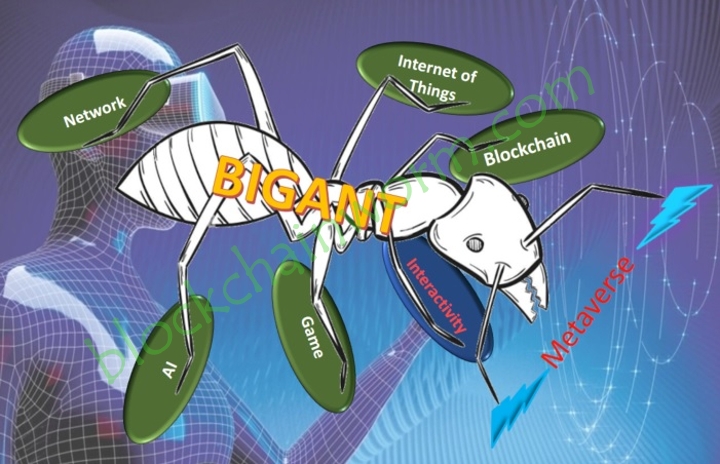Page Contents :
What Is Interactivity
In the previous post, we discussed the application of Blockchain Technology in the Metaverse ![]() .
.
In this post, we will delve into another core technology in the Metaverse BIGANT – Interactivity.
Interactivity is the integration of advanced technologies like Hologram, 3D Modeling, Extended Reality (XR), Brain-Computer Interface (BCI or Brain-Machine Interface BMI), and more.
Which allows users to seamlessly interact with the virtual environment.
With the metaverse becoming a popular destination for entertainment, socializing, and work, creating immersive experiences is crucial for success.
User Experience (UX) has become increasingly important, and users now seek realistic and sensitive experiences in virtual environments.
Interactivity plays a crucial role in enabling users to engage with the virtual world more natural and intuitive way.
Interactive technology can respond to users in real-time, enhancing their immersion in the virtual environment.
With interactivity, the metaverse can replace the low-interactivity smartphone to provide more engaging and immersive experiences for users.
Mirror World From Hologram
In the context of the metaverse, a Mirror World is a virtual replica of the real world.

Hologram technology is particularly advantageous in creating mirror worlds due to its ability to display images in a way that mimics the real world.
This technology works by using light to create the illusion of 3D objects in space.
By projecting images into the air, hologram projection creates a visual experience that is both immersive and interactive.
This means that users can interact with the virtual environment in much the same way as they would in the real world.
It creates a more engaging user experience, which is critical to the success of any virtual environment.
In addition, the use of hologram technology allows for the creation of previously impossible virtual environments.
For example, imagine walking through a fairy tale forest with talking trees and magical creatures.
With hologram technology, this fantasy world can become a reality.
This technology can also be used to create separate virtual areas of historical or cultural sites virtually, allowing users to explore these sites in an interactive way never before possible.
Hologram technology can provide a more realistic and immersive mirror world with greater interactivity and engagement.
Its potential applications are vast, including entertainment, education, and industry, and have undoubtedly revolutionized the development of the metaverse.
3D Modeling For Immersive And Surreal Scenes
The world of the metaverse creates a space where everything is possible.
In this virtual world, the boundaries of the real world do not exist and the possibilities for creative expression are endless.
The key to unleashing the full potential of the metaverse is to transport users to an alternate reality through immersive environments.
This is where 3D Modeling technology comes in, and it is a key component in creating these immersive experiences.
3D modeling involves a variety of techniques, including polygon modeling, NURBS modeling, and procedural modeling.
Each technique has its advantages and disadvantages, and they are used in different contexts depending on the desired outcome.
Regardless of which technique is used, the benefits of 3D modeling in the metaverse are enormous.
One of the important advantages of 3D modeling is the level of control it provides to the creator.
It allows them to create environments that would not be possible in the real world, and they can manipulate every aspect of the environment.
This level of control provides the user with a sense of agency that feels natural and provides a more immersive experience.
However, there are potential challenges to using 3D modeling in the metaverse .
One of the most important challenges is the processing power required to render these environments.
Because of the high demands on processing power, it can be challenging to create an immersive experience that is accessible to a wide range of audiences.
Despite this challenge, 3D modeling technology has the potential to revolutionize the metaverse by providing immersive experiences that transport users to an alternate reality.
It allows creators to build environments that would not be possible in the real world and provides users with an unparalleled sense of agency.
As technology continues to advance, the potential of 3D modeling in the metaverse is endless, and we have only scratched the surface of what is possible.
Fully Immersive Experience With Extended Reality
The integration of Virtual Reality (VR) and Augmented Reality (AR) in Extended Reality (XR) Technology provides a fully immersive and interactive experience for users.
XR allows users to interact with virtual environments while maintaining a connection to the real world.
One potential application of XR technology is the integration of movies and concerts into a virtual world, blurring the boundaries between the real and virtual realms.
Users can watch a movie or concert while being fully immersed in the experience and ability to interact with the virtual environment in real-time.
The potential of XR technology in the field of virtual entertainment is enormous.
It can create unique, fully immersive experiences.
XR can take users to any location or environment, from the depths of the ocean to the surface of Mars, providing unprecedented interactivity and immersion.
In addition, XR technology has the potential to provide users with unparalleled interactivity and a high level of engagement and immersion through a form of virtual entertainment.
It can make users feel like they are part of the experience, rather than simply watching it.
This can lead to a deeper emotional connection with the content and a more memorable and engaging experience for the user.
This creation has the potential to revolutionize the entertainment industry and create new worlds that are more exciting and never thought possible.
Realistic Experience Of Brain-Computer Interface
The Brain-Computer Interface (BCI) technology is a cutting-edge innovation that has the potential to revolutionize the way we interact with the virtual world.
Through BCI, brain activity is translated into commands that can be used to control devices such as virtual or real environments.
This enables us to interact with the virtual world using only our senses.
One of the key goals of BCI technology is its ability to provide a sensory experience that is as close to reality as possible.

Which is why Haptic Gloves were developed to allow us to feel the virtual world through haptic feedback.
This feedback includes sensations such as pressure, vibration, and temperature, which helps create a more immersive and realistic experience.
The potential impact of BCI technology on the sensory experience of the metaverse is enormous.
It could lead to the creation of lifelike virtual environments that can be experienced in ways previously unimaginable.
the use of BCI technology could revolutionize the gaming industry by allowing players to feel as if they were actually in the game, with all the associated sensory input.
In summary, BCI technology is an exciting and rapidly evolving area of research.
It has the potential to change the way we interact with virtual worlds.
With the help of haptic gloves and other sensory feedback devices, BCI technology has the potential to create truly immersive and realistic experiences.
Virtual Community
In Virtual Communities, interactivity is the driving force behind building relationships and creating a sense of community.
The metaverse is more than just a collection of virtual experiences and spaces;
It provides an opportunity for users to engage with one another and foster a sense of community.
User-generated content is a key element in facilitating community building,
Users can customize their avatars, create virtual families, and form their communities.
Much like the Minecraft ![]() player community, players passionately create and share new content with each other.
player community, players passionately create and share new content with each other.
This level of engagement cultivates a sense of connection and belonging, which is vital to virtual community building.
World of Warcraft ![]() , for example, is a game that successfully builds a strong sense of community through its interactive features.
, for example, is a game that successfully builds a strong sense of community through its interactive features.
Its players create a sense of camaraderie within the virtual community and even being able to connect in real life.
Interactive features can help foster social connections and create a sense of shared identity in the virtual world.

And communities like VRChat ![]() have diverse communities that gather users from around the world to form strong relationships.
have diverse communities that gather users from around the world to form strong relationships.
The immersive quality of interactive experiences is unparalleled in non-interactive experiences.
Interactive experiences create a sense of presence and help users stay engaged with other users and virtual communities.
Challenges Of Interactivity
Designing and Implementing interactive features in a metaverse can be challenging.
One of the primary challenges is ensuring that the features are easy to use and intuitive for all users.
Optimization of interactive features for different devices and connection speeds is another challenge that designers face.
Another important aspect of interactive feature design in the metaverse is ensuring accessibility for users with disabilities.
This can be addressed through assistive technologies like Text-To-Speech (TTS) and Closed Captioning (CC) features.
Despite these challenges, there are several emerging trends in the design of interactions in the metaverse that offer exciting opportunities to enhance the user experience.
One trend is the use of immersion and haptic feedback, which can help create a more engaging and immersive user experience.
Another trend is the adaptation of interactive features to the specific needs and preferences of individual users.
This can be done using artificial intelligence and machine learning to personalize the user experience.
Future Development
The future of the metaverse is promising, with interactivity being a crucial factor in its success.
It fosters engagement, community building, and personalization, which are all essential in creating a truly immersive and engaging user experience.
In short, interactive features must be designed with balance and consideration of other design principles.
And ensure accessibility, usability, and optimization for different devices and connection speeds.
As technology continues to advance, developers can create more sophisticated and advanced ways for users to interact with virtual environments.
This will lead to the development of new forms of interactive functionality and more advanced interfaces.
By designing and implementing these engaging interactive features, developers can shape a more immersive and engaging metaverse.
Furthermore, the integration of the virtual and real worlds can create memorable and engaging user experiences, revitalizing new business models.
The future of the metaverse is an exciting prospect, and it will undoubtedly revolutionize the way we interact with technology and with each other.




